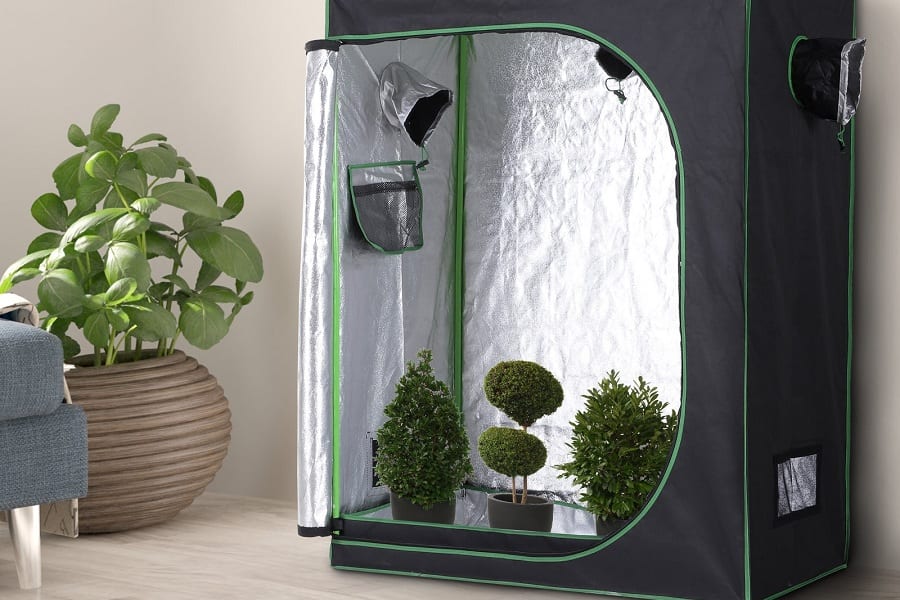Gardening is a great source of joy for many people and it’s the ideal way to relax and unwind.
When the weather becomes unmanageable and the pests take over it’s a different story though, and the once relaxing hobby is now a hindrance.
A grow tent is the ideal way to bypass these external factors while still enjoying many of the benefits of gardening but it can be an expensive investment but a worthwhile one.
With a tent of your own that lets you control light, shade, temperature, hydration, ventilation, and pests, you’re able to create the perfect setting for your plants, with far greater results.
How do you create a DIY grow tent, then?
If you want to make a grow tent of your own, you’ll need the right materials for a tent, adequate lighting, a ventilation system, and methods to monitor temperature, humidity, and other factors.
It’s easy enough to create a DIY grow tent to save money from purchasing one that’s ready-made, and they can be just as effective.
If you’ve been thinking about getting into grow tent gardening but want to do it cheaply, a DIY tent could be right up your alley.
We’ll walk you through the steps to make your own tent and what’s crucial to their success, so you’ll have everything required to get started in this new gardening venture.
Table of Contents
What is a Grow Tent?
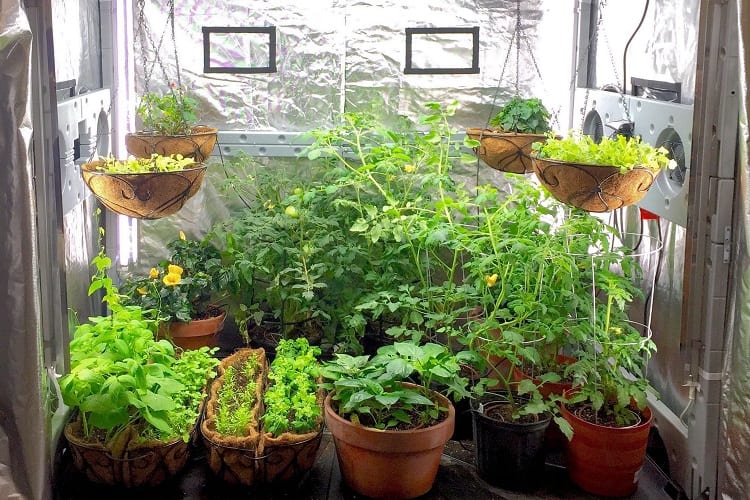
A grow tent is a simple name for an indoor structure that houses the growth of plants inside.
These structures are usually compact tents that feature reflective walls on the inside that create ideal light conditions with a darkly covered exterior material to prevent light from coming in.
The purpose of these tents is to create a specific environment that allows plants to thrive, as the owner can adjust settings like light, shade, temperature, and airflow.
By having the plants indoors, they’re less susceptible to attacks from disease and pests, but care still needs to be taken.
Grown tents come in different sizes but usually are designed to fit in small spaces, including coat closets.
You can create a grow tent with a few basic materials like LED lights and reflective material or purchase a ready-made kit that has all of the parts required.
The Best Plants for a Grow Tent

Grow tents aren’t just for illegal activity, and there are loads of species of plant that thrive in these types of conditions.
These are some suggestions for what to grow in your tent once you get it up and running.
- Strawberries
- Beans
- Kale
- Mushrooms
- Sunflower
- Lavender
- Marigold
Many of these plants work well when growing together and having them in the same living space can be beneficial for their growth.
They may have separate requirements for light, shade, and temperature, but you can work with the various compartments of your tent to get it right for each of them.
The Requirements for a Grow Tent
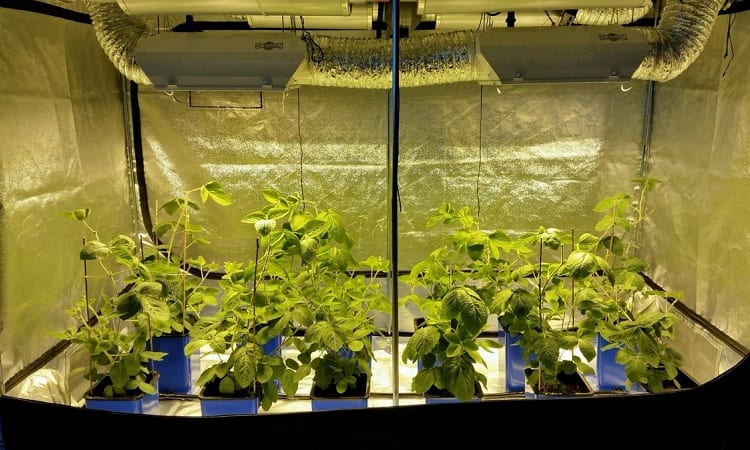
A grow tent must replicate the perfect living conditions for the plants inside of it and it should mimic the outdoors perfectly, imagining the right weather, light, and shade that a garden offers.
You’ll need to consider all of these important parts of grow tent before you plan on building one, with each as important as the last.
Lighting
LED lights are the most popular choice for grow tents and the easiest to source.
The most common advice is to provide between 30 to 50 watts of lighting for every square foot of space inside your grow tent. For vegetables specifically, you can go even lower at around 25 watts per square foot.
Ventilation
Air is important for plants, just as it is for humans, and because the tent will be sealed up to stop the light from coming it, it won’t get air naturally.
You’ll need a fan with the right CFM (cubic feet per minute) rating with the most common choices being four, six, and eight inches in diameter.
Cover
Most grow tents have two levels of cover: interior and exterior. The interior is a white or silver reflective material that allows all parts of the plants to receive light.
The exterior’s purpose is to keep the exterior light out so that it can remain controlled inside. Some also come with odor-repellent qualities if that’s of concern to your garden.
Storage
Grow tents come in many configurations depending on what you’re growing and the size requirements it has.
You can have shelves, compartments, hangers, and more, as long as the light and space allow it.
Step by Step DIY Grow Tent
If you’re looking to cut costs but still want all of the benefits of a grow tent, you’re in luck. It’s easy enough to create a DIY grow tent at home provided you can check off all the basic requirements.
Check out this step-by-step guide to get it done with ease.
Assemble a frame
Use a PVC or metal pipe to create the base frame for your tent. The size of the tent will depend on how many plants you’re growing inside and whether it will have various compartments.
Cover with material
With a sturdy frame assembled, you can now cover it with your chosen materials.
You’ll need an inner layer of white reflective material and then an outer layer of black canvas material. Give yourself an access point or entryway and make room for the lighting and fan.
Install lighting
Install your chosen LED or other lights into the grow tent, making sure to hang them the recommended height above where the plants are located. Pull the power cord out through the cover and then tape it up around the hole so no light can filter through.
Install fan
Read the guidelines from the manufacturer to determine the best setup for the fan so the air intake is correct. The best placement is usually on the floor.
Monitor conditions
Before you bring any plants in, make a note of the light, temperature, and humidity conditions over the coming few days. Once you’ve recorded a steady reading, you can bring in the plants.
The Costs of DIY vs Ready Made
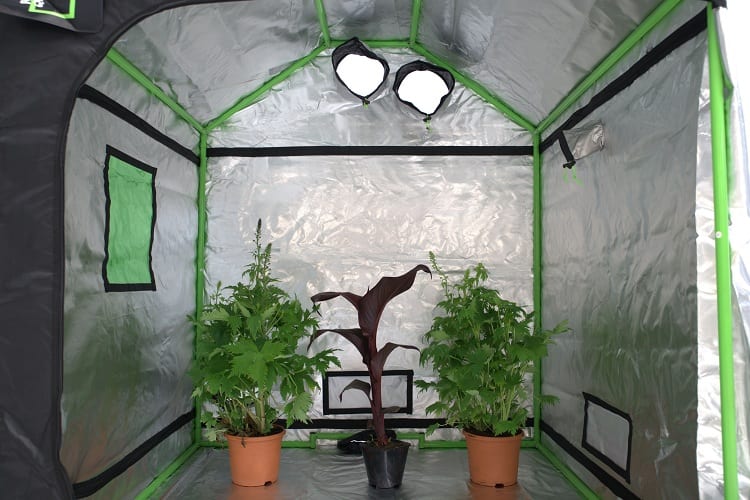
There are loads of grow tents available to purchase with all of the working parts included, like lighting and ventilation systems.
However, depending on their quality and price, it usually works out cheaper to assemble your own tent with some expertly sourced materials, costing around $200 for a full setup.
For a DIY tent, you have to be prepared to shop around will need to know what to look for in a quality fan or LED setup, so it’s not ideal for everyone.
These days, you can find cheaper alternatives for kits online that have everything you need, which could be ideal for people who are just starting or unsure about what, and for a basic level tent kit it costs around $200 as well.
The DIY Way to Grow Indoors
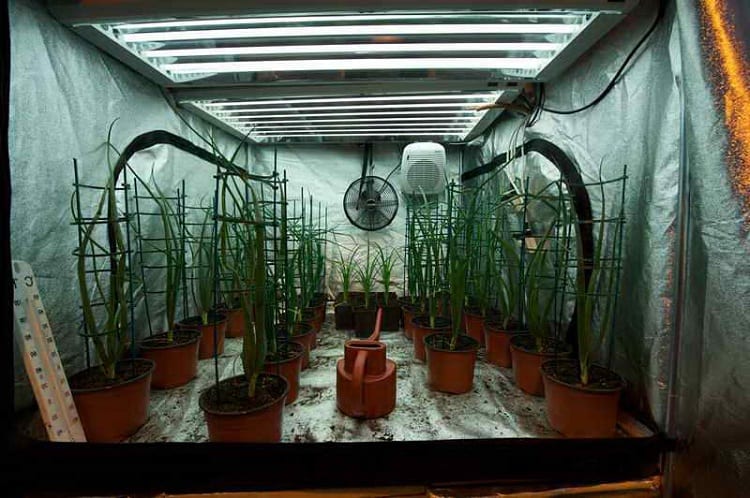
Most people assume that grow tents were only designed for cannabis plants or illegal activity, but this couldn’t be farther from the truth.
A grow tent is a must-have for any gardening fanatic who wants to make the most of the conditions indoors and keep an eye on their most prized plants.
With a few simple materials and a little know-how, you can easily make a DIY grow tent and start to explore this unique style of gardening.
You’ll save hundreds of dollars in the process and create the perfect microclimate for your plants to thrive, so it’s a journey worth undertaking.
Related Questions
A grow tent is an efficient way to grow plants, fruits, vegetables, and flowers inside, while being in total control of external factors.
If you’ve been thinking about making a grow tent of your own but still have more questions, check out these FAQs to give you a push in the right direction.
Some vegetables and herbs do well in the conditions created in a grow tent, but for the best results, you’ll want to stick to leafy greens and common herbs.
Choices like spinach, lettuce, watercress, and kale perform well under LED lights and are easy to bring to harvest using a grow tent setup.
Purchasing a grow tent kit with all of the parts included like ventilation and lighting can be an expensive investment at first, but if you’re growing plants that you’ll use or sell, it will pay for itself eventually.
Consider making your own DIY tent with separately assembled parts to cut costs while still being effective.
Recourses:

